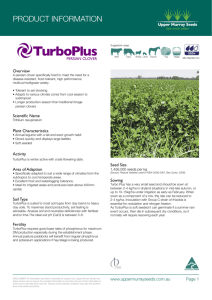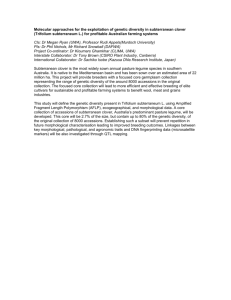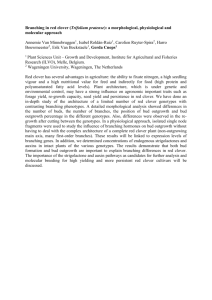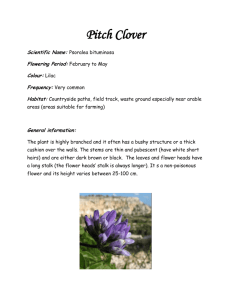2007 Field Day booklet country.
advertisement
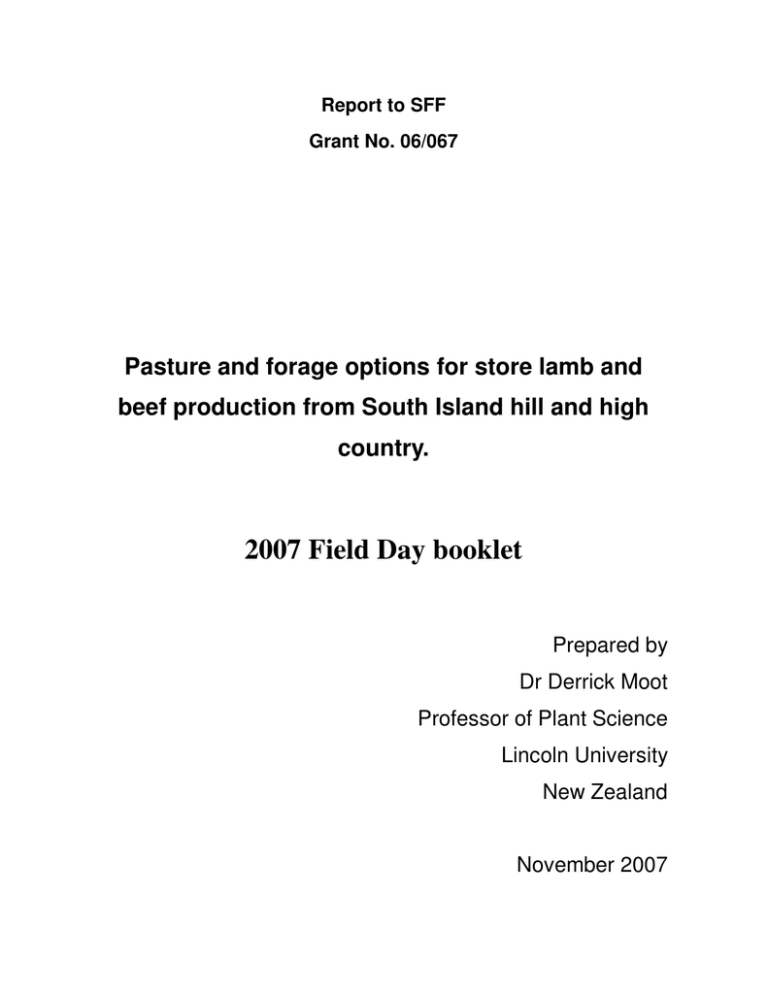
Report to SFF Grant No. 06/067 Pasture and forage options for store lamb and beef production from South Island hill and high country. 2007 Field Day booklet Prepared by Dr Derrick Moot Professor of Plant Science Lincoln University New Zealand November 2007 Lees Valley Farmer’ Farmer’s Group Field day Pasture and forage options for SI hill and high country 8 november 2007 LandCo Farming, Wharfedale Station Photo: LU FSC ii Programme 1.00 pm 1.30 pm An introduction to Lees Valley – Mr Oliver Dickson (LandCo Farming) Comparison of ± cultivation, two drill types and three rates of lime when sowing permanent pasture into herbicide, undeveloped, depleted grassland – Dick Lucas and Ed Tapp 2.00 pm Perennial grass growth ± nitrogen – Dr Anna Mills 2.30 pm Legumes and Herbs – Professor Derrick Moot and Mr Dick Lucas 3.00 pm Annuals and Forages – Dr Warwick Scott 3.30 pm Pasture Mixtures – Professor Derrick Moot 4.00 pm Lucerne sowing date and rate – Professor Derrick Moot N.B. Times may be subject to change depending on the number of visitors. BBQ to follow at the LandCo Farming office, Wharfedale Station iii Lees Valley Farmer’s Group Background: The Lees Valley Farmer’s Group includes 20 farmers, managers and farm staff in and around the Lees Valley area of North Canterbury. We include farmers from LandCo Farming Ltd, who coordinate some management of the trial plot and provided financial assistance to the wider applicant group. The core applicant group was formed in January 2005 to discuss agronomic issues related to the intensification of Lees Valley. At this point scientists from Lincoln University were invited to discuss potential ideas for development. Together the group successfully sourced funding from the MAF Sustainable Farming Fund to establish a demonstration site in the Lees Valley. The aim of the group is to provide a research and extension site for public discussion and debate on pasture options for intensifying hill and high country areas lead by agronomists from Lincoln University. Farmers within the group were surveyed about the issues relevant to them and ranked topics for demonstration on site and at their own properties. Issues most commonly identified were: • Pasture species combinations • Nitrogen on pasture • Fertilizers and brassicas • Caucasian clover establishment • Annual clover establishment and management • Sowing rates of pastures • Lucerne grazing management • Oversowing on steeper hill country Based on this feedback a series of demonstrations and experiments has been established on a 10 ha site. The aim of the field day is to enable a wider audience to see the range of issues being tackled and provide some preliminary data for discussion. The opportunity is for attendees to take messages from this environment to apply to their own on-farm situation. Farmers wishing to be placed on the mailing list to receive updates are invited to complete the attendance sheet record accordingly. A full time technician is employed to monitor pasture growth and plot management. Senior students from Lincoln University are involved in research projects based around the plots and an army of overseas visitors has been enlisted as volunteer workers to assist with harvests and data collection. A weather station has been installed to allow site specific rainfall, temperature, wind run and radiation data to be collected and this is used to assist in interpreting pasture growth. The Group has funding to maintain the site until June 2009. At that point MAF will reassess the situation and may provide additional funding if the applicant group and wider audience (you) see benefit in continuing some or all of the monitoring. Given that persistence and production are important attributes of dryland pasture species we are hopeful that the opportunity will present itself to maintain the site beyond the first commitment period. 1 Comparison of ± cultivation, two drill types and three rates of lime when sowing permanent pasture into undeveloped, depleted grassland Dick Lucas and Ed Tapp N N = No cultivation C = Disc and harrow TD = Duncan triple disc drill Rep 4 CS C+ CS TD N+ C+ TD N+ CS = Baker cross slot drill D C+ T N+ TD C+ Rep 1 CS N+ N+ C+ TD TD Rep 3 TD N+ TD C+ CS N+ C+ CS CS S N+ C C+ CS Rep 2 e Le ey all V s ro ad Background: The Lees Valley farmer’s group is interested in the relative cost benefits of various inputs when establishing permanent pasture directly into depleted tussock grassland. Basal treatments • Round up (3 l/ha) sprayed mid December 2006 to kill resident grasses prior to autumn sowing, for successful establishment. • Superphosphate broadcast on all plots at 400 kg/ha on 22 February 2007 • DAP spread at 350 kg/ha on triple disc plots on 22 February 2007 prior to sowing on 28 February. • Cultivated plots disced twice on 22 February, harrowed on 26 February. • DAP applied at 350 kg/ha in cross slot drill plots 7 March 2007 beside seed. Seed Sowing rate (kg/ha) ‘AR1’ perennial ryegrass 10 ‘Ella’ cocksfoot 1 ‘Nomad’ white clover 2 ‘Leura’ subterranean clover 4 ‘Woogenellup’ subterranean clover 4 ‘Kaituna’ lucerne (pelleted) 1 (All legumes inoculated with appropriate Rhizobium strains the day before sowing). 2 Treatments Main plots 1. No cultivation plus triple disc drill 2. No cultivation plus cross slot drill 3. Disc and harrow plus triple disc drill 4. Disc and harrow plus cross slot drill Initial Soil Quick Test pH 5.3, Olsen P 9, Ca 2, Mg 15, K 8, Na 4, S 5 The cross slot drill has i Improved ability to sow at a consistent depth due to presence of gauge wheels. ii Seedlings are not as susceptible to desiccation because embryonic root exploration in the inverted T-shaped slot is not hindered by compacted slot walls. iii Placement of fertiliser in a concentrated band beside, but not with, the seed. This reduces the occurance of fertiliser toxicity or ‘seed burn’. The triple disc drill has • One cutting disc and two opening discs, placing the seed in a V shaped slot. Fertilizer is drilled with seed or else broadcast. Results to 2nd October 2007 • Cultivated treatment had 656 kg DM ha-1 vs the non cultivated 292 kg DM ha-1(p<0.05). • Cross Slot drill had 542 kg DM ha-1 vs triple disc drill of 406 kg DM ha1 (p = 0.09). • 6 t ha-1 of lime produced 555 kg DM ha-1 vs 430 kg DM ha-1 from 0 and 2 t ha-1 of lime (p<0.05). Total green dry matter production (kg ha-1) and botanical composition (%) of pasture grown with and without cultivation and two drill types on the 2nd October, after establishment in a depleted tussock grassland at Lees Valley, Canterbury 2007 (From Tapp 2007). Total green dry matter (kg ha-1) % Ryegrass % Subterranean clover % Cocksfoot % White clover % Weed Cultivated 656 66.8 26.4 0.68 3.01 2.7 Non cultivated 292 39.6 33.7 1.27 6.32 19.0 0.011 0.031 0.052 NS NS 0.087 Cross Slot 542 59.2 21.4 1.22 4.98 12.9 Triple disc 406 47.2 38.6 0.73 4.34 8.8 Treatment Significance Significance 0.081 0.061 0.008 3 NS NS NS Cost benefit analysis of establishment methods Total cost of pasture establishment includes cost of basal treatments; spraying, seed, fertiliser including transport and spreading, plus cost of treatment. Total cost of pasture establishment, with and without cultivation, with two drill types and with 0, 2 or 6 t ha-1 of lime in a depleted tussock grassland at Lees Valley, Canterbury 2007 (From Tapp 2007). Rate of lime (t ha-1) 0 2 6 Cross Slot $1,022 $1,123 $1,325 Triple disc $925 $1,026 $1,228 Cross Slot $822 $923 $1,125 Triple disc $725 $826 $1,028 Cultivated Non cultivated • The cost of the cultivated treatment was 1.22 times greater than non cultivated treatment. • The cost of the Cross Slot drill treatment was 1.1 times greater than triple disc drill treatment. • The cost of lime including transport and spreading was $50 tonne-1. The average cost was $873 ha-1 for 0 t of lime ha-1, $974 ha-1 for 2 t of lime ha-1 and $1176 ha-1 for 6 t of lime ha-1. • The total cost of 6 t of lime ha-1 was 1.35 times greater compared with 0 t of lime ha-1. Applying 6 t of lime ha-1 was not cost effective at this time but the lime response is likely to be ongoing. Note: only sprayed once pre-sowing because of the dry autumn meant there was no regrowth to spray. 4 Photo: LU FSC Initial disc cultivation of resident tussock / browntop after herbicide application 5 Perennial grass species • The site was initially sprayed with round up (4l/ha) in April 2005 and again in October. Lime applied at 5 t/ha. Browntop mat broken down by hoof and tooth from April to August 2005. 400 kg/ha superphosphate and 300 kg/ha DAP applied in January 2006 then disced, harrowed and heavy rolled. • Eight species were sown 13 February 2006. Revolution ryegrass and Bareno brome were sown 1 November 2006 • Plots were grazed April, September, November 2006, January and June 2007. They were topped in December 2006. • The dry matter production range from 1 August 2006 to 20 June 2007 is between 5.6 and 3.3 t DM/ha for Aries HD 10 kg/ha and Timothy respectively. The later sown Bareno brome and Revolution ryegrass produced 2 t DM/ha. There was no difference in dry matter production (p>0.05) for the Aries HD 5, 10 and 15 kg/ha from April 2006 – July 2007 (5.3, 5.6 and 5.5 t DM/ha accumulated respectively). • Under drought conditions Kara cocksfoot and Advance tall fescue produced higher dry matter (1750 and 1460 kg DM/ha respectively in April)(p<0.05) compared to other species (Aries HD 15 kg seeds/ha; 1240 kg DM/ha). Soil Quick Test pH 6.1, Olsen P 16, Ca 9, Mg 8, K 9, Na 2, S 9 at 8 August 2007 6 Total Dry Matter Yield (t/ha) 5 6 5.6 5.5 5.3 Aries 5 kg/ha Aries 10 kg/ha Aries 15 kg/ha 5 4 4 3 3 2 2 1 1 0 6 5 Cocksfoot Gala Brome Tall Fescue 0 Aug06 Cannon LE Timothy Revolution Bareno Brome Dec06 4.9 6.3 4.5 4.3 5.8 Apr07 Aug07 5.1 4 3.3 3 2.3 2 1.7 Perennial grasses Cumulative dry matter production (t/ha) 1 0 Aug06 Dec06 Apr07 Date 6 Aug07 Accumulated annual dry matter production of irrigated cocksfoot pastures with or without N fertiliser Dr Anna Mills Accumulated annual DM production of irrigated cocksfoot pastures with or without N fertiliser 25 Accumulated DM yield (t/ha) 21.9 20 15 9.8 10 5 0 0 1000 2000 3000 Accumulated Tt (oCd, Tb = 3oC) • At Lincoln, fully irrigated cocksfoot pastures supplied with non-limiting N fertiliser had more than double the yield of pastures with irrigation alone. • Both pastures used about 700 mm of water annually to produce these yields. • Cocksfoot is highly competitive for moisture and out-competes most legumes. • For dryland properties – spring N (50 kg N/ha) will increase cocksfoot growth, water use efficiency and grazing preference. • At Lees Valley pasture plots have been split in half. One half received no N fertiliser and the other 150 kg N/ha as calcium ammonium nitrate on 15 Aug 2007. • Photo: LU FSC The high rate of N fertiliser applied here is experimental. Data will be used to develop a nitrogen nutrition index which will allow N fertiliser recommendations to be made regardless of location, season or previous site history. 7 Legumes and herbs • Alsike (3.5 kg/ha), white (4 kg/ha), red (5kg/ha), subterranean (10 kg/ha), balansa (3 kg/ha) clovers, chicory (0.6 kg/ha), plantain (1 kg/ha) and lucerne (10 kg/ha) were sown 8 – 13 February 2006. Site preparation same as for perennial grasses. • Caucasian clover (Cc) was over drilled in chicory and plantain treatments and sown with rape on November 1 2006. • Production was between 4.6 for red clover and 1.2 t/ha for caucasian clover alone, from August 2006 to June 2007. • White clover is expected to loose its taproot after 12 – 18 months. • Subterranean and balansa plots now heavily infested with weeds. Lack of subterranean seedlings in autumn was due to high percentage of hard seed. • Plots were grazed September and November 2006, January and June 2007. Soil Quick Test pH 6, Olsen P 17, Ca 7, Mg 10, K 11, Na 2, S 8 at 8 August 2007 Red Clover White Clover Lucerne 4 Alsike Clover Plantain/Cc Balansa Clover 4.6 4.3 4.0 4 Total Dry Matter Yield (t/ha) 2 3.0 3.0 2.9 2.9 2.4 2.4 2 0 0 Aug06 Dec06 Apr07 Aug07 Dec07 Sub Clover Chicory/Cc Caucasian Clover 4 2.1 2.0 2 1.2 0 Aug06 Dec06 Apr07 Aug07 Lees Valley Legumes/Herbs Cumulative Dry Matter Production (t/ha) Dec07 Date 8 Photo: LU FSC Sub clover; winter chill 9 Caucasian clover establishment Caucasian clover (Cc) requires a specific rhizobium strain to form effective N fixing root nodules Cc rhizobia are not present in NZ soils. Therefore, all Cc seed must be freshly inoculated shortly before sowing with the correct strain of Cc specific rhizobia. Rhizobium bacteria are sensitive to ultra violet light, dessication and high temperatures. If sowing is delayed, the inoculated, pelleted seed should be kept in a dark, cold, dry place. Takes longer to form a canopy of leaves Cc has the same rapid rate of germination, emergence and primary shoot development seen in most clover species. However, the thermal time required to start production of the secondary growing points, which are required to rapidly produce a canopy of leaves, is much longer for Cc than perennial ryegrass or white clover (see graph below). For example, ryegrass begins tillering after 400oCd, Wc initiates stolons after 430oCd but Cc takes 1200oCd for its first crown shoots and ~1600oCd (most of a growing season) for secondary leaf production. Number of leaves per plant 25 Cc primary Wc primary Pg primary Cc total Wc total Pr total 20 Cc 15 Wc Pr 10 5 0 0 200 400 600 800 1000 1200 1400 Accumulated thermal time (°Cd) after sowing Number of total and primary stem leaves for seedlings grown at 25/15 ºC against accumulated thermal time above a base temperature of 0 ºC. Arrows indicate the time of initiation of secondary growing points, either tillers (pr), stolons (wc) or crown shoots (Cc). Spring sowing best The aim should be to sow early enough to accumulate 1600oCd (degree days) before April. 10 Best practice Cc establishment a) Cultivated seed-beds i. Incorporate lime and fertilizer (no N) into the soil based on recent soil test results. ii. Create a weed free, firm, fine seed-bed for sowing in spring when soil temperatures exceed 10°C. iii. Use appropriate herbicides before cultivation and pre and/or post emergence as needed. iv. Drill in spring 5 kg/ha of freshly inoculated Cc seed (at time of sowing). A roller drill may be best to replace seed at 10 mm depth, in rows no wider than 15 cm. v. A pure stand of Cc sown in spring and overdrilled in autumn with permanent pasture species or winter feed will give the fastest Cc establishment. Seed mix options • Sow rape (e.g. Winfred) with Cc at 1 kg/ha (less if N fertility is high, more if N is low). An early grazing may be needed to avoid the rape canopy shading out the clover. Other pasture species, including annual clovers in summer dry areas, can then be overdrilled in autumn. • Half normal rates of plantain or chicory have also been used as nurse crops for Cc but rape provides the most rapid bulk of feed with a leaf canopy which is compatible with the clover. • Slower establishing grasses (sown at half commercial rates) such as timothy (1 kg/ha) or tall fescue (10 kg/ha) have also been used with Cc in spring sowings. • Grasses sown with Cc will slow the clovers development depending on soil N levels; perennial ryegrass in particular is highly competitive with its rapid seedling establishment and at conventional (15-20 kg/ha) rates. On moderate fertility sites 5 kg/ha of perennial ryegrass is sufficient when sown with Cc in spring. b) Direct drilling i. Follow advice as for cultivated seed-beds. ii. Double spray to ensure complete kill of resident vegetation and weeds. iii. Soil N levels will tend to be lower than after cultivation. Companion species are therefore likely to be less competitive than if the same paddock had been cultivated. iv. Ideally use a cross-slot drill to place fertiliser in the soil near, but not in contact with the seed and take care with monitor sowing depth. v. Fertilizer and lime surface broadcast will not increase topsoil nutrient levels as rapidly as cultivation. Photo: LU FSC 11 Dryland brassicas Dr Warwick Scott • Brassicas produce about 20 kg/ha of dry matter (DM) per mm of water used. • Shallow-rooted crops (turnips and swedes) are more sensitive to soil moisture deficit than deeper-rooted ones (kale and rape). • Yield is limited by the amount of water available from stored soil water and in-season rainfall. • Most brassica crops will extend their roots to about 1.0 m depth. • Water available in the 1.0 m root zone ranges from about 80 mm in light, shallow soils to about 140 mm in heavier, deeper soils. • Fallow before sowing to conserve water in soils with low water holding capacity. Typical available soil water holding capacities (mm) Soil Depth to gravel (m) Swedes, Turnips (0.6 m root depth) Kale, Rape (1.0 m root depth) 0.20 65 80 0.30 80 90 0.50 100 110 0.75 130 140 1.00 130 165 • Provide an optimum rooting environment for crops. • Sow early to allow survivial through mid and late season drought. • Choose brassica types that grow mainly at less droughty times of the year. • Maximise productive use of available water. • Manage crops so they can best take advantage of rainfall when it occurs. 12 Green globe turnips with nitrogen and phosphorus Back ground • Site established April 2005 sprayed with round up (4 l/ha) and again in October. Browntop mat broken down by hoof and tooth from April to August 2005. • 400 kg/ha super phosphate and 300 kg/ha DAP applied in January 2006 then disc, harrow and heavy rolled. Glyphosate (540 g/l a.i. at 2 l/ha) applied September 2006. • Green globe turnip sown at 1.5 kg/ha and 100 kg C.A.N. broadcast over all plots (21 kg N/ha – first application) on 14 December. • Second application of N (20 kg/ha to designated 40 kg N/ha plots) applied 28 February 2007. Final application of N (20 kg/ha to designated 60 kg N/ha plots)14 March 2007. • Three treatments of Phosphorus (0, 30 and 60 kg P/ha) applied prior to sowing. Results • Maximum turnip dry matter production occurred on the 28 February at an average yield of 3640 kgDM/ha, before the drought reduced yield to 2460 kgDM/ha in early May. 400 Leaf Bulb TDM 350 300 Yield (g/m²) 250 200 150 100 50 0 Feb Mar Apr May Jun Jul Aug Sep Date Yield of turnips (Brassica campestris L.) over time, showing leaf, bulb and total dry matter accumulation. Error bars are LSD at the 10% level (From Reynolds 2007). 13 Kale • Sown 9 November 2006 at 3 kg/ha. • Half of the plots had nitrogen applied (urea) at 30 kg N/ha on 8 May. Results • The yield rose from 1580 kg DM/ha in mid-January and reached a maximum of 6230 kg DM/ha in mid-June. 700 600 Kale Leaf Kale Stem Kale TDM 500 Yield (g/m²) 400 300 200 100 0 Jan Mar May Jul Sep Date Yield of kale (Brassica oleracea L.) over time, showing leaf, stem and total dry matter accumulation. Error bars are LSD at the 10% level (From Reynolds 2007). Radiation Interception • The light interception was low in May, due to incomplete leaf canopies after the drought. • Kale recovered quicker, responded to nitrogen and produced higher yields by mid winter than turnips. • 30 kg N/ha produced 2180 kg DM/ha more by mid June compared to no autumn N application (70 kg DM/ha increase per unit of N). • Light interception increased as the plants redevelop leaf canopies after the drought. • At the start of May the proportion of radiation intercepted was 33% for turnips and 59% for kale. • By mid July radiation interception had increased to 46% for turnips and 76% for kale. 14 Photo: LU FSC Kale growing at Mt Pember station, 2006 15 Annuals (2006 sowing) • Annuals are used to provide quality feed over the 120 + day winter at Lees Valley. • Initially six treatments were sown 13 February 2006. • Cereals sprayed with glyphosate 16 January 2007. Herbage Available (kg DM/ha) 2006 2007 Sowing rate (kg/ha) Autumn (26 April) Winter (16 Sept) Spring (26 Oct) Early Summer (7 Dec) Mid Summer (16 Jan) Triticale 100 1663 a 834 a 432 b 1563 a 2289 b Oats 100 1774 a 376 b 204 c 740 b 2826 a Ryecorn 100 1074 b 1043 a 746 a 2210 a 1623 c Significance *** *** *** *** *** LSD (P<0.05) 384 290 160 669 509 Species/cultivar Italian ryegrass 20 648 b 762 ab 784 b 3326 b 2265 Quartet ryegrass 23 723 b 524 b 526 c 1989 b 2502 Maverick Gold short rotational ryegrass 20 870 a 1109 a 1208 a 5673 a 2736 Significance *** ** *** *** NS LSD (P<0.05) 384 375 244 1563 2007 cont’d; Herbage Available (kgDM/ha) Mid autumn (18 Apr) Late autumn (17 May) Mid Winter (1 July) Late Winter (8 Aug) Early Spring (6 Sept) Italian ryegrass 20 1291 999 588 270 262 Quartet ryegrass 23 1781 1381 959 482 447 Maverick Gold short rotational ryegrass 20 1815 1353 965 345 317 NS NS NS NS NS Significance • • • • Light graze April, September, October 2006 and August 2007 Rapid growth in early summer followed by topping in December 2006 High rainfall in December lead to an increase in dry matter production over January. Low rainfall between January and April and moderate temperatures resulted in a decrease in dry matter production. 16 Annuals (2007 sowing) • Sonik annual ryegrass sown 30th January 2007 • Cereals sown 21st March 2007 into previous cereal or fallow plots Herbage Available (kg DM/ha) Sowing Rate (kg/ha) Mid autumn (18 Apr) Late autumn (17 May) Mid winter (1 July) Late winter (8 Aug) Early spring (6 Sept) Mid spring (25 Oct) Sonik ryegrass 30 881 1055 a 768 612 227 1029 Oats 100 413 714 ab 1389 780 172 339 Ryecorn 100 549 466 bc 1006 602 229 1258 Triticale 100 353 278 c 586 345 240 1210 NS * NS NS NS NS Significance LSD 414 • Grazed in August 2007 • Sonik showed fast establishment and strong autumn growth activity. Growth was reduced after temperatures decreased in winter. • Oats have strong winter growth activity and,compared to the other cereals, has higher frost tolerance. October results show slow re-growth after grazing. Soil Quick Test pH 6.0, Olsen P 14, Ca 7, Mg 8, K 10, Na 2, S 8 at 8 August 2007 17 Pasture species mixtures • Sprayed with glyphosate in early November 2006 and left fallow for three months • Sown on 30 January 2007. • All plots have a basal clover mixture of ‘Leura’ subterranean clover at 10 kg/ha and ‘Nomad’ white clover at 2 kg/ha. Perennial Ryegrass Dry matter (kg/ha) Grass treatment Sowing rate (kg/ha) Emergence (plants/m2) Revolution AR1 10 372 842 Cannon HE 10 504 612 Revolution + Cocksfoot * 10 2 344 44 847 Revolution AR1 20 562 857 Samson AR1 10 276 818 Significance * Agriseeds fine-leaved cocksfoot (dg25) June NS June botanical composition (%) Sown grass Subterranean Clover White Clover Weed Dead Revolution AR1 (10 kg) 55 11 3 0 31 Cannon HE 44 19 2 0 35 Revolution + CF 38 10 8 3 41 Revolution AR1 (20 kg) 51 8 2 0 39 Samson AR1 40 13 3 0 44 Signficance NS NS NS NS NS • Dead percentage high due to no grazing in autumn Soil Quick Test pH 5.7, Olsen P 12, Ca 5, Mg 7, K 7, Na 2, S 8 at 8 August 2007 18 Pasture mixtures cont’d Dryland Mixes Dry matter (kg/ha) Sowing rate (kg/ha) Emergence (plants/m2) ‘Advance’ tall fescue 20 87 794 ‘Advance’ tall fescue +endophyte 20 208 730 ‘Bareno’ brome 20 360 781 Agriseeds cocksfoot (dg25) 2 58 643 ‘Ella’ cocksfoot 2 56 653 Grass treatment June Significance NS June botanical composition (%) Grass Subterranean Clover White Clover Weed Dead Other Grass ‘Advance’ tall fescue 5b 55 16 0 23 1 ‘Advance’ tall fescue +endophyte 16b 45 14 0 25 0 ‘Bareno’ brome 61a 15 4 0 20 0 Agriseeds cocksfoot 20b 39 8 10 20 31 ‘Ella’ cocksfoot 20b 40 14 3 23 0 Signficance ** NS NS NS NS NS LSD 19.8 SEM 6.1 • Botanical composition indicates Bareno brome had a greater (p<0.05) percentage of grass content than other treatments • Bareno brome is slower to establish than ryegrass, however it is faster than cocksfoot or tall fescue. • Clover percentage was subsequently lower in Bareno brome plots. Soil Quick Test pH 5.7, Olsen P 16, Ca 5, Mg 9, K 11, Na <2, S 10 at 8 August 2007 19 Pasture mixtures cont’d Timothy Mixtures Dry matter (kg/ha) Sowing rate (kg/ha) Emergence (plants/m2) ‘Kahu’ timothy 2 63 584 ‘Kahu’ timothy + Chicory 2 1 66 315 339 ‘Kahu’ timothy + red clover 2 4 55 174 550 ‘Kahu’ timothy, Plantain + Chicory 2 1 1 66 174 208 311 ‘Kahu’ timothy + Plantain 2 1 57 232 511 Timothy/herb mixture June Signficance NS June botanical composition (%) Grass Sub WC RC Plant Chic Weed Dead Other Grass ‘Kahu’ timothy 3 49 16 - - - 1 31 0 ‘Kahu’ timothy + Chicory 13 41 10 - - 6a 0 30 0 ‘Kahu’ timothy + red clover 4 68 6 4 - - 0 18 0 ‘Kahu’ timothy, Plantain + Chicory 7 31 8 - 14 0b 0 40 0 ‘Kahu’ timothy + Plantain 3 41 3 - 12 - 2 39 0 NS NS NS NS NS *** NS NS NS Signficance LSD 3 SEM 7 • The botanicals showed no significant differences in grass or clover content • Clover percentage was higher in timothy plots compared to ryegrass and dryland mixtures due to slower establishing timothy Soil Quick Test pH 5.8, Olsen P 16, Ca 5, Mg 8, K 9, Na <2, S 11 at 8 August 2007 20 Photo: LU FSC Timothy seedling in pasture mix. 21 Lucerne (sowing date and rate) • The site was initially sprayed with round up (4l/ha) in April 2005 and again in October. Browntop mat broken down by hoof and tooth from April to August 2005. • 400 kg/ha superphosphate and 300 kg/ha DAP applied in January 2006 then disced, harrowed and heavy rolled. • Sown with 20 kg/ha Feast annual ryegrass in February 2006, then grazed May and September 2006 • Glyphosate (540 g/l a.i. at 2 l/ha) applied November 2006. Soil Quick Test pH 5.7, Olsen P 12, Ca 4, Mg 8, K 11, Na <2, S 8 at 8 August 2007 - 40 m Sowing 1 (14/12/2006) 1 7 2 13 3 10 4 16 Sowing 4 (12/3/2007) 5 10 6 7 7 16 8 13 Sowing 2 (16/1/2007) 9 16 10 13 11 7 12 10 Sowing 3 (28/2/2007) 13 13 14 7 15 10 16 16 17 10 18 16 7 20 13 21 13 22 7 23 10 24 16 25 7 26 13 27 16 28 10 29 16 30 10 31 13 32 7 Sowing 2 33 16 34 10 35 13 36 7 Sowing 3 37 13 38 7 39 10 40 16 Sowing 4 41 10 42 16 43 7 44 13 45 7 46 13 47 16 48 10 Sowing 4 Sowing 2 Sowing 1 Sowing 3 Sowing 1 19 24 m 6m N 10 m Results Plant populations • Lucerene stands sown on the 14 December had the highest (201 plants/m2) number of plants while those sown on the 16 January had the least (95 plants/m2). • The total number of plants that survived the first winter was highest from the December and January sowings. • Plant numbers for 16 kg/ha sowing rate (160 plants/m2) were higher than those from 7 and 10 kg/ha sowing rate (98 plants/m2). • The decline in the number of seeds sown to the number that survived to spring can be seen in in the graph on the next page. 22 Average number of lucerne seeds sown (seeds/m2), emergence on various dates (plant/m2) and survival as at 12 September 2007, from 7 (♦), 10 (▲), 13 (■) or 16(●) kg seed/ha sowing rates, at Lees Valley, Canterbury. Error bars are LSD (p<0.05) for (a) emergence and (b) survival (from Lewis 2007). • The two latest sowing dates February and March have been sprayed with Round-up (2 l/ha) and will be left to see what recovers. 23 Lees Valley (LV) weather summary Keith Pollock An automated weather station was erected on the flats of Wharfedale station in November 2006. Data for the first year are summarized below and compared to data from Darfield and the ECAN rain record from near Island Hill across the valley (due North from trial site, on the Ashley River). Month Nov06 Dec06 Jan07 Feb07 Mar07 Apr07 May07 Jun07 Jul07 Aug07 Sep07 Oct07 Means /Totals Air temp. (°C) Soil temp. (°C) Rainfall (mm) Wind(km/hr) Solar Rad. LV 11.5 11.1 14.8 14.4 15.1 9.1 9.7 3.3 3.4 5.2 7.9 9.7 Darfield 12.8 12.3 14.8 15.5 16.5 11.1 11.9 5.7 5.9 7.1 9.5 10.7 LV 13.0 14.2 16.0 15.8 14.9 11.2 8.7 4.2 3.4 5.5 8.0 9.5 LV(ECAN) Darfield 139.0 100.2 135.5 95.2 29.0 27.2 49.0 18.8 18.0 38.8 64.5 51.2 57.5 38.4 73.5 50.6 42.5 41.2 41.5 28.6 58.5 33 187.5 81.2 Mean 3.3 2.4 2.1 1.6 2.3 1.3 2.4 1.9 1.4 2.0 8.3 15.8 Max 26.8 17.9 16.1 13.3 24.0 13.2 24.7 25.5 17.8 63.0 77.8 105.5 9.6 11.2 10.3 3.8 105.5 Darfield LV 15.4 89.0 15.7 105.8 17.6 16.6 19.7 30.2 18.5 13.6 12.8 37.2 10.0 33.8 4.8 48.8 5.0 26.0 6.6 26.0 9.5 28.0 11.0 109.0 12.2 56.4 89.7 50.4 MJ/m2/day 17.9 17.4 16.9 16.1 14.0 9.3 6.7 5.1 5.4 8.5 11.3 16.2 12.0 Darfield data are courtesy of Selwyn Plantation Board and ECAN rainfall data are courtesy Environment Canterbury. Rainfall updates from the ECAN network are available by phone or their web page @ http://www.ecan.govt.nz/Our+Environment/Water/Rainfall/ • Mean monthly LV (Wharfedale) rainfall was 65% of the ECAN site across valley, r2 =0.95; and 95% of the Darfield rainfall, r2 = 0.82. • Lees Valley was 1 °C cooler than Darfield in summer; 2 °C colder in winter. 24 Mixtures Legume/herbs Oats(21Mar07) 2 Quartet I White clover 3 Italian Rg 4 Barkant (9Nov06) Lucerne Aries HD 10kg/ha 5 Sonik 30Jan07 XXXXXXXX Cocksfoot 6 Pasja 14Dec06 Plantain/Cc Bareno Brome 7 Ryecorn(21Mar07) Balansa clover Aries HD 15kg/ha 8 Triticale(21Mar07) Alsike clover CannonLE 9 Maverick Caucasian clov Gala Brome Red clover Timothy Sub clover Tall fescue 10 Ryecorn(21Mar07) sown 30 Jan 07 Dryland grasses and clovers 3 reps x 5 treatments plot size = 6x40m Kahu timothy chicory/plantain and clovers 3 reps x 5 treatments plot size = 6x40m 11 Barkant (9Nov06) 12 Italian Rg Revolution II Lucerne 13 Ryecorn(21Mar07) Red clover Gala Brome 14 XXXXXXXX Aries HD 10kg/ha 15 Pasja 14Dec06 White clover Timothy 16 Sonik 30Jan07 Alsike clover Aries HD 5kg/ha 17 Oats(21Mar07) Caucasian clov Revolution 18 Quartet Balansa clover Bareno Brome 19 Maverick Chicory/Cc Aries HD 15kg/ha 20 Kale (9Nov06) Plantain/Cc Cocksfoot Sub clover Tall fescue Oats(21Mar07) 21 Triticale(21Mar07) 22 Oats(21Mar07) CannonLE White clover Cocksfoot 24 Sub clover Gala Brome 25 Lucerne Aries HD 15kg/ha 26 Quartet Caucasian clov Timothy 27 Italian Rg Chicory/Cc Revolution 28 1 Globe & PxN XXXXXXXX Aries HD 10kg/ha 29 Balansa clover Tall fescue 30 Sonik 30Jan07 Plantain/Cc Bareno Brome Alsike clover Aries HD 5kg/ha 2 Globe & PxN 31 Maverick Lucerne: 3 reps x 4 dates x 4 rates Plots 6x10 m 20m III Red clover 23 Maverick 32 Kale (9Nov06) CannonLE IV Alsike clover 33 Triticale(21Mar07) Chicory/Cc Gala Brome 34 Quartet XXXXXXXX CannonLE 35 Ryecorn(21Mar07) Caucasian clov Tall fescue 36 Italian Rg Red clover Aries HD 15kg/ha 37 Pasja 14Dec06 White clover Revolution 38 Sonik 30Jan07 Plantain/Cc Bareno Brome 39 40 3 Globe & PxN 15m Sub clover Balansa clover Lucerne Cocksfoot 15m Timothy Aries HD 5kg/ha N 40m 25 Gate Aries HD 10kg/ha <== Lees Valley Road ==> plot size = 6x40m Aries HD 5kg/ha 10m 3 reps x 5 treatments Perennial grass Chicory/Cc 9m Rygrasses and clovers Annual/forage 1 90m sown 30 Jan 07 Pasture mixtures: grass/clover/herbs Experiment Ryegrass I Perennial Ryegrass 30 m II 96 m 3m III Rep Plot# Trt# Grass/forbs 1 1 1 1 1 1 2 3 4 5 1 3 5 4 2 Revolution AR1 10kg Cannon HE 10kg Revolution 10 kg & Cf (dg25) Revolution AR1 20kg Samson AR1 10kg 2 2 2 2 2 6 7 8 9 10 3 2 5 4 1 Cannon HE 10kg Samson AR1 10kg Revolution 10 kg & Cf (dg25) Revolution AR1 20kg Revolution AR1 10kg 3 3 3 3 3 11 12 13 14 15 2 5 4 1 3 Samson AR1 10kg Revolution 10 kg & Cf (dg25) Revolution AR1 20kg Revolution AR1 10kg Cannon HE 10kg 1 1 1 1 1 1 2 3 4 5 1 5 3 4 2 Advance Tf Ella Cf Bareno brome Agriseeds dg25 Cf Advance Tf +endophyte 2 2 2 2 2 6 7 8 9 10 1 2 5 4 3 Advance Tf Advance Tf +endophyte Ella Cf Agriseeds dg25 Cf Bareno brome 3 3 3 3 3 11 12 13 14 15 2 5 1 4 3 Advance Tf +endophyte Ella Cf Advance Tf Agriseeds dg25 Cf Bareno brome 1 1 1 1 1 1 2 3 4 5 4 5 3 1 2 Kahu timothy & chic/pltn Kahu timothy & red clover Kahu timothy & plantain Kahu timothy Kahu timothy & chicory 2 2 2 2 2 6 7 8 9 10 1 3 5 4 2 Kahu timothy Kahu timothy & plantain Kahu timothy & red clover Kahu timothy & chic/pltn Kahu timothy & chicory 3 3 3 3 3 11 12 13 14 15 2 1 5 4 3 Kahu timothy & chicory Kahu timothy Kahu timothy & red clover Kahu timothy & chic/pltn Kahu timothy & plantain 6m Dryland mix Dryland grasses I II 300 m III 6m Timothy Kahu timothy I II III Plus basal clover: 40 26 Leura sub clover (10kg coated/ha) and Nomad white clover (2 kg/ha) Photo: LU FSC Newly established pasture mixes; Advance tall fescue on left, the basal clover (centre) and Bareno brome at right Photo: LU FSC Balansa clover with Triticale for silage harvesting. 27
